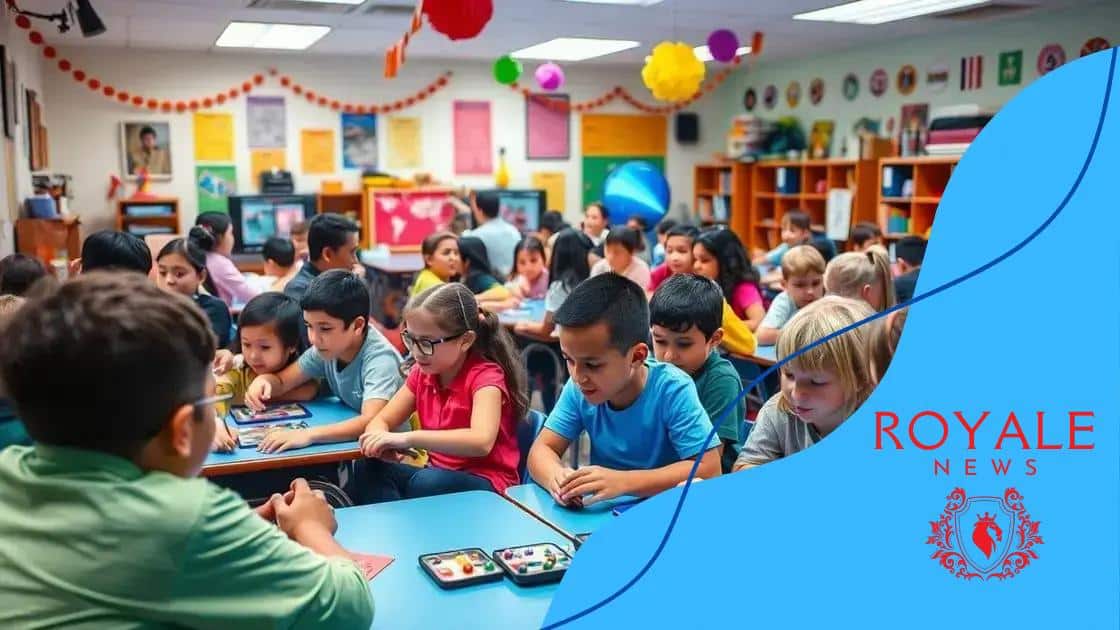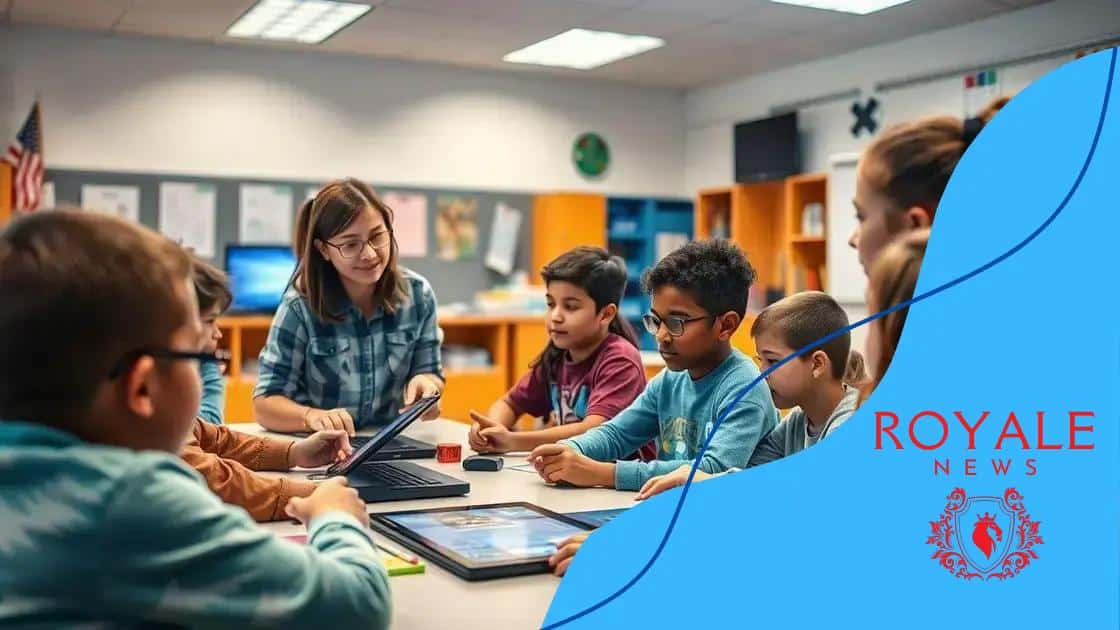Gamified learning experiences for students: engage and empower

Gamified learning experiences enhance student engagement and motivation by integrating game elements into educational activities, leading to improved retention and learning outcomes.
Gamified learning experiences for students can transform traditional education into an engaging adventure. Have you ever wondered how games can motivate students? Let’s dive into the exciting world of gamification!
Understanding gamified learning
Understanding gamified learning is essential for creating engaging educational environments. By integrating game-like elements into lessons, teachers can boost students’ motivation and improve learning outcomes. This approach transforms the classroom into a dynamic space where learning becomes an adventure.
What is Gamified Learning?
Gamified learning combines educational concepts with game mechanics. These mechanics include rewards, points, and challenges, making learning exciting. Think of it like turning your lesson into a game!
Benefits of Gamified Learning
This method offers numerous advantages:
- Increased Engagement: Students are more likely to participate actively.
- Improved Retention: Learning becomes memorable when it’s fun.
- Encouragement of Teamwork: Many games foster collaboration.
When students are engaged, they tend to perform better. Gamified experiences create an environment where failure is not feared but embraced as part of the learning process.
By integrating feedback loops, students can see their progress and adjust their strategies accordingly. This continuous engagement can lead to greater self-efficacy and motivation.
Key Elements of Gamified Learning
To implement gamified learning effectively, consider including:
- Clear Objectives: Set achievable goals for students.
- Progress Tracking: Allow students to track their advancement.
- Rewards System: Use badges or points to incentivize learning.
Each of these elements contributes to a well-rounded gamified experience that can truly enhance learning and retention. By understanding gamified learning, educators can create environments where students thrive.
Key benefits of gamified experiences
Exploring the key benefits of gamified experiences reveals how this approach can transform education. When students engage in gamified learning, they not only enjoy their studies but also enhance their skills.
Enhanced Motivation
One of the most notable benefits is the increase in student motivation. Games create a sense of achievement and allow students to experience fun while learning. This motivation encourages them to participate actively in their lessons.
Improved Learning Outcomes
Gamification also leads to better educational results. Students often retain information more effectively when it is delivered in a game format. This makes the learning experience memorable.
Development of Essential Skills
Through gamified experiences, students can develop critical thinking and problem-solving skills. Working on challenges in a game-like environment provides practical experience that can be applied in real-life situations.
- Critical Thinking: Students learn to analyze problems carefully.
- Creativity: Gamified experiences encourage out-of-the-box thinking.
- Collaboration: Many games require teamwork, fostering cooperation among peers.
Gamification also promotes a growth mindset. Students learn that failure is part of the process and can push them to improve continuously. This contributes significantly to building resilience.
Instant Feedback
Another benefit of gamified learning is the availability of instant feedback. Students can quickly see their progress, which encourages them to keep trying and improving. This immediate response enhances learning, as students can adjust their strategies and approaches in real time.
In summary, understanding the key benefits of gamified experiences provides educators with powerful insights to enhance the learning process. By incorporating these elements, teachers can create a more engaging and effective educational environment for their students.
Techniques to implement gamification

Implementing gamification in education requires effective techniques to engage students. By using various strategies, educators can create an exciting learning environment that motivates students to participate actively.
Incorporate Game Mechanics
Utilizing game mechanics is essential for creating a gamified experience. Elements like points, badges, and leaderboards can create competition and encourage participation. When students see their progress displayed, they become more motivated to improve.
Set Clear Goals
Establishing specific, measurable goals helps students understand what they need to achieve. These objectives guide their learning and provide a sense of direction. Clear goals make students more accountable and focused on their progress.
- Define challenges: Create tasks that are challenging yet achievable.
- Provide immediate feedback: Offering quick responses helps students adjust their strategies.
- Encourage collaboration: Use team-based challenges to foster teamwork.
Effective feedback not only helps students learn but also keeps them engaged. When they know how they are doing, they can adapt their efforts based on the feedback.
Use Storytelling
Another powerful technique is the use of storytelling in lessons. Narratives can captivate students and immerse them in the learning experience. A well-crafted story can provide context to the material, making it more relatable and memorable.
By presenting challenges in a story format, students may feel more invested in overcoming them. This engagement can lead to deeper understanding and retention of the material.
Integrate Technology
Many digital platforms offer gamification tools. These platforms can enhance the learning experience by integrating quizzes, interactive content, and simulations. Utilizing technology allows educators to reach students in ways that resonate with their interests.
Overall, the techniques to implement gamification are diverse and adaptable. By combining various strategies, educators can create a vibrant and engaging learning environment that appeals to all students.
Best tools for creating gamified learning
Choosing the best tools for creating gamified learning can significantly enhance the educational experience. With a variety of options available, educators can find platforms that suit their needs and style.
1. Kahoot!
Kahoot! is a popular game-based learning platform that allows teachers to create quizzes, surveys, and interactive lessons. The competitive nature of this tool makes it engaging for students, encouraging them to participate actively. Students can answer questions on their devices while enjoying a lively classroom environment.
2. Classcraft
Classcraft takes gamification to the next level by merging classroom management with gaming elements. Students earn points and unlock rewards based on behavior and performance. This tool makes it possible to create a more engaging and positively reinforcing learning environment.
- Customizable avatars: Students can create their characters, enhancing their experience.
- Collaborative quests: Enhances teamwork and social skills.
- Behavior management: Friendly competition encourages positive actions.
Integrating platforms like Classcraft allows students to experience learning as an adventure.
3. Quizizz
Quizizz is another tool that allows teachers to create fun quizzes with engaging visuals and sounds. Students can play at their own pace, making it less stressful and more enjoyable. Educators can easily track progress and understanding.
4. Edpuzzle
Edpuzzle provides a unique way to enhance video content with quizzes and questions. Teachers can take existing videos and integrate interactive elements, making passive viewing an active learning experience. This tool encourages students to think critically about the material they watch.
The best tools for gamified learning vary based on educational goals. However, incorporating these platforms can lead to increased student engagement and improved educational outcomes. By using technology to create immersive experiences, educators can revolutionize the classroom experience.
Case studies of successful gamification
Exploring case studies of successful gamification provides valuable insights into how gamified strategies enhance learning. These real-world examples demonstrate the impact of gamification across different educational settings.
1. Duolingo
Duolingo is a language-learning app that uses gamification to motivate users. With a point system, badges, and levels, learners feel a sense of achievement as they progress. This method not only makes learning a new language fun but also encourages consistent practice. The app has millions of active users daily, showcasing the effectiveness of gamified learning.
2. Class Dojo
Class Dojo is another remarkable case. It focuses on classroom management by rewarding students for positive behavior. Teachers use a point system to track students’ achievements, fostering a supportive community in the classroom. This approach led to increased engagement and better behavior among students.
- Improved Classroom Culture: By recognizing positive actions, students feel valued.
- Parental Engagement: Parents can track their child’s progress through the app.
- Peer Recognition: Students celebrate each other’s successes, promoting teamwork.
Such initiatives underline the importance of creating a positive learning atmosphere.
3. The University of Cape Town
The University of Cape Town implemented a gamified system in its teaching methods, aiming to encourage student participation in online assessments. By introducing leaderboards and achievement badges, the results showed a notable increase in student engagement and assessment scores. This example illustrates how gamification can enhance academic performance and retain student interest in course materials.
Case studies of successful gamification reveal various strategies that institutions employ to engage students. By learning from these examples, educators can adopt effective gamification tactics that foster a more interactive and enjoyable learning experience.
FAQ – Frequently Asked Questions about Gamified Learning Experiences
What is gamification in education?
Gamification in education incorporates game elements into learning activities to enhance engagement and motivate students.
How can gamified learning improve student motivation?
Gamified learning increases motivation by making lessons more enjoyable through the use of points, badges, and competition.
What are some popular tools for implementing gamification?
Popular tools for gamification include Kahoot!, Classcraft, Quizizz, and Edpuzzle, which facilitate interactive and engaging learning experiences.
Can you provide examples of successful gamification in classrooms?
Examples include Duolingo for language learning and Class Dojo for classroom management, both showing increased engagement and improved outcomes.





